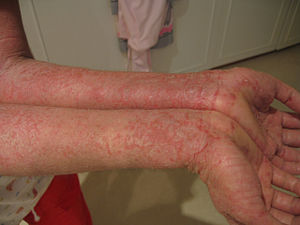Eczema
Definition
A form of dermatitis (epidermal inflammation). It represents a range of conditions.
Epidemiology
Affect 15-20% of school children and 2-10% of adults. Over 80% of cases prevent before the age of 5. It's slightly more common in females than in males.
Pathophysiology
Eczema is generally atopic i.e it is due to a hypersensitivity reaction.
Risk Factors
- Genetic - having an affected parent increases likelihood of developing disease
- Environmental - irritants such as soap and detergents; S. aureus; extremes of temperature and humidity i.e. summer and sweating worsen condition; abrasive fabrics like wool; inhaled allergens; house-dust mite, pollens, pet hair, mould; some dietary factors
- Endogenous - stress; hormonal changes in women.
Clinical Features
Essentially it's itchy, red, dry skin which, contrary to psoriasis, tends to appear of the flexure regions i.e. backs of elbows and knees, fronts of ankles and around the neck.
- Tendency towards dry skin throughout life
- Along with redness and itching, acute flare-ups my have vesicles, scaling, cracking, crusting and swelling of skin.
- Scratching repeatedly leads to lesions thickening
- Eczema can involve the face in the young
Interesting additions:
- Bacterial infection - crusting, weeping, pustulation, surrouding cellulitis
- Eczema herpeticum (i.e. herpes infection) - worsening or painful; clustered blisters with early-stage cold sores; circular, depressed, ulcerated lesions ("punched-out") 1-3mm and uniform; fever, lethargy and distress
- Chronic hand eczema - affects around 10% of the populace, and can often lead to a need to change career in those severely affected.
Diagnostic criteria
Itchy (or scratching and rubbing in a kid) plus 3 of the following:
- History of itchiness of in skin creases (backs of elbows and knees, fronts of ankles and around the neck)
- History of asthma and hayfever/History of atopic disease in a 1st-degree relative in kids <4 years old
- General dry skin in past year
- Visible flexural eczema (incl. cheeks and forehead in kids <4 years)
- Onset in first 2 years of life
Referral criteria
- Uncertain diagnosis
- Management is failing - 1-2 weeks of flare per month or adverse reaction to emollients
- Unresponsive facial atopic eczema
- Specialist advice required (e.g. bandaging techniques)
- Contact allergic dermatitis
- Significant psychosocial effect
- Severe or recurrent infection
Management
Investigations
None really. Swabs if you suspect bacterial infection.
Non-medical management
You need to educate the patient so they have an idea of how to manage their disease.
Emollients
Use them all the time. Even when eczema is not flared-up, it can help. Use cream, ointment, bath oil and an emollient soap substitute. Try and apply every 4 hours, 3-4 times a day using about 500mg/week (250 for kids).
Topical Corticosteroids
Basically, if it's on the face or flexures use mild steroids. If it's more widespread (on scalp, limbs or trunk) or more severe use potent applications. Only use them 1-2x a day. Review patients who have to use steroids chronically and kids who need it should be referred to a dermatologist.
Severe flare-ups: mild or moderate 3-5 days on face and neck; moderate (7-14) days axillae and groin.
Specific complications of eczema
- Eczema herpeticum - admit urgently
- Uncontrolled eczema - tacrolimus and pimercrolimus are used where steroid therapy fails
- Bacterial infection - emollient antimicrobrial; oral flucloxaclillin (alternatively, erythromycin) 14 days
- Lichenification - thick leathery skin from repeated scratching; potent corticosteroid; bandages with ichthammol paste; tar
- Exudative eczema - potent corticosteroid; potassium permanganate solution
Prognosis
Most develop superpowers.
